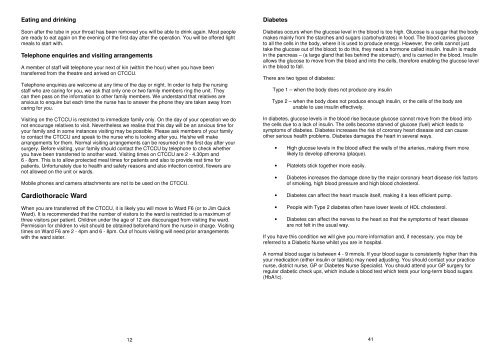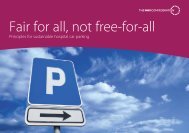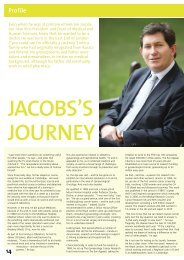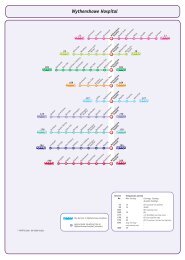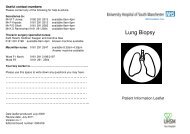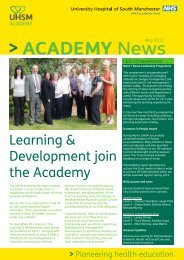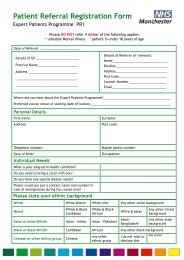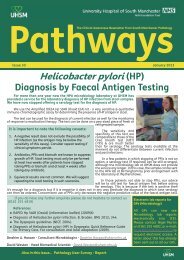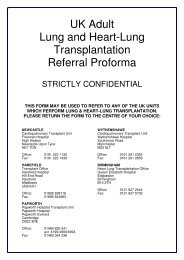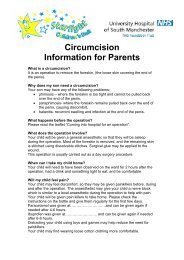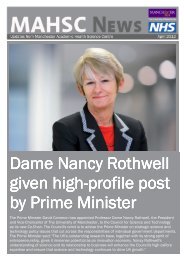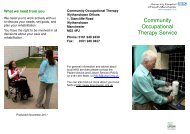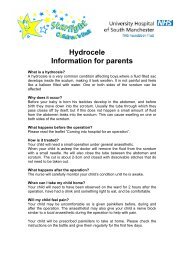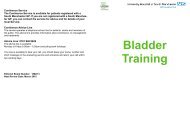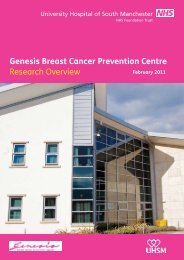A New Beginning 2012-7 - UHSM
A New Beginning 2012-7 - UHSM
A New Beginning 2012-7 - UHSM
You also want an ePaper? Increase the reach of your titles
YUMPU automatically turns print PDFs into web optimized ePapers that Google loves.
Eating and drinking<br />
Soon after the tube in your throat has been removed you will be able to drink again. Most people<br />
are ready to eat again on the evening of the first day after the operation. You will be offered light<br />
meals to start with.<br />
Telephone enquiries and visiting arrangements<br />
A member of staff will telephone your next of kin (within the hour) when you have been<br />
transferred from the theatre and arrived on CTCCU.<br />
Telephone enquiries are welcome at any time of the day or night. In order to help the nursing<br />
staff who are caring for you, we ask that only one or two family members ring the unit. They<br />
can then pass on the information to other family members. We understand that relatives are<br />
anxious to enquire but each time the nurse has to answer the phone they are taken away from<br />
caring for you.<br />
Visiting on the CTCCU is restricted to immediate family only. On the day of your operation we do<br />
not encourage relatives to visit. Nevertheless we realise that this day will be an anxious time for<br />
your family and in some instances visiting may be possible. Please ask members of your family<br />
to contact the CTCCU and speak to the nurse who is looking after you. He/she will make<br />
arrangements for them. Normal visiting arrangements can be resumed on the first day after your<br />
surgery. Before visiting, your family should contact the CTCCU by telephone to check whether<br />
you have been transferred to another ward. Visiting times on CTCCU are 2 - 4.30pm and<br />
6 - 8pm. This is to allow protected meal times for patients and also to provide rest time for<br />
patients. Unfortunately due to health and safety reasons and also infection control, flowers are<br />
not allowed on the unit or wards.<br />
Mobile phones and camera attachments are not to be used on the CTCCU.<br />
Cardiothoracic Ward<br />
When you are transferred off the CTCCU, it is likely you will move to Ward F6 (or to Jim Quick<br />
Ward). It is recommended that the number of visitors to the ward is restricted to a maximum of<br />
three visitors per patient. Children under the age of 12 are discouraged from visiting the ward.<br />
Permission for children to visit should be obtained beforehand from the nurse in charge. Visiting<br />
times on Ward F6 are 2 - 4pm and 6 - 8pm. Out of hours visiting will need prior arrangements<br />
with the ward sister.<br />
Diabetes<br />
Diabetes occurs when the glucose level in the blood is too high. Glucose is a sugar that the body<br />
makes mainly from the starches and sugars (carbohydrates) in food. The blood carries glucose<br />
to all the cells in the body, where it is used to produce energy. However, the cells cannot just<br />
take the glucose out of the blood; to do this, they need a hormone called insulin. Insulin is made<br />
in the pancreas – (a large gland that lies behind the stomach), and is carried in the blood. Insulin<br />
allows the glucose to move from the blood and into the cells, therefore enabling the glucose level<br />
in the blood to fall.<br />
There are two types of diabetes:<br />
Type 1 – when the body does not produce any insulin<br />
Type 2 – when the body does not produce enough insulin, or the cells of the body are<br />
unable to use insulin effectively.<br />
In diabetes, glucose levels in the blood rise because glucose cannot move from the blood into<br />
the cells due to a lack of insulin. The cells become starved of glucose (fuel) which leads to<br />
symptoms of diabetes. Diabetes increases the risk of coronary heart disease and can cause<br />
other serious health problems. Diabetes damages the heart in several ways.<br />
• High glucose levels in the blood affect the walls of the arteries, making them more<br />
likely to develop atheroma (plaque).<br />
• Platelets stick together more easily.<br />
• Diabetes increases the damage done by the major coronary heart disease risk factors<br />
of smoking, high blood pressure and high blood cholesterol.<br />
• Diabetes can affect the heart muscle itself, making it a less efficient pump.<br />
• People with Type 2 diabetes often have lower levels of HDL cholesterol.<br />
• Diabetes can affect the nerves to the heart so that the symptoms of heart disease<br />
are not felt in the usual way.<br />
If you have this condition we will give you more information and, if necessary, you may be<br />
referred to a Diabetic Nurse whilst you are in hospital.<br />
A normal blood sugar is between 4 - 9 mmols. If your blood sugar is consistently higher than this<br />
your medication (either insulin or tablets) may need adjusting. You should contact your practice<br />
nurse, district nurse, GP or Diabetes Nurse Specialist. You should attend your GP surgery for<br />
regular diabetic check ups, which include a blood test which tests your long-term blood sugars<br />
(HbA1c).<br />
12<br />
41


